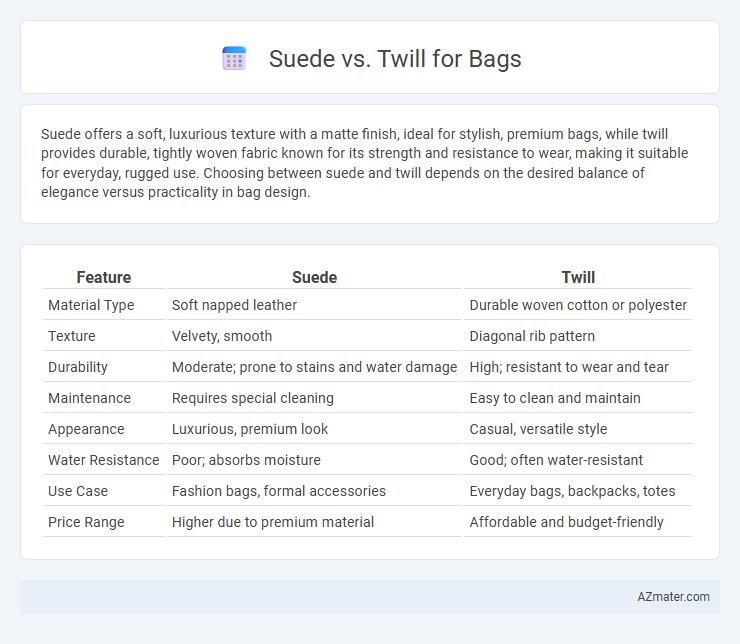Suede offers a soft, luxurious texture with a matte finish, ideal for stylish, premium bags, while twill provides durable, tightly woven fabric known for its strength and resistance to wear, making it suitable for everyday, rugged use. Choosing between suede and twill depends on the desired balance of elegance versus practicality in bag design.
Table of Comparison
| Feature | Suede | Twill |
|---|---|---|
| Material Type | Soft napped leather | Durable woven cotton or polyester |
| Texture | Velvety, smooth | Diagonal rib pattern |
| Durability | Moderate; prone to stains and water damage | High; resistant to wear and tear |
| Maintenance | Requires special cleaning | Easy to clean and maintain |
| Appearance | Luxurious, premium look | Casual, versatile style |
| Water Resistance | Poor; absorbs moisture | Good; often water-resistant |
| Use Case | Fashion bags, formal accessories | Everyday bags, backpacks, totes |
| Price Range | Higher due to premium material | Affordable and budget-friendly |
Introduction to Suede and Twill
Suede, characterized by its soft, napped finish, is derived from the underside of animal hides, offering a plush texture and elegant appearance often favored in luxury bags. Twill fabric features a distinctive diagonal weave pattern, known for durability and resistance to wrinkles, making it a practical choice for sturdy, everyday bags. The contrast between suede's delicate, tactile quality and twill's robust, textured weave highlights the distinct advantages each material brings to bag design and functionality.
What is Suede?
Suede is a type of leather made from the underside of animal hide, characterized by its soft, napped texture and matte finish. It is prized for its luxurious feel and aesthetic appeal but requires careful maintenance due to its susceptibility to stains and water damage. This material is often chosen for bags when a stylish, velvety surface is preferred over the more structured and durable twill fabric.
What is Twill?
Twill is a type of fabric characterized by its distinct diagonal weave pattern, which enhances durability and resistance to wrinkles, making it ideal for bags exposed to everyday wear. Unlike suede, which is a soft, napped leather with a velvety texture, twill is typically made from cotton, polyester, or blends, offering greater strength and easy maintenance. This sturdy weave structure also provides a smooth surface that resists dirt, making twill a practical choice for long-lasting, functional bags.
Appearance and Texture Comparison
Suede bags offer a soft, velvety texture with a matte finish that exudes a luxurious and elegant appearance, ideal for a refined look. Twill bags feature a distinctive diagonal weave pattern, providing a durable and slightly textured surface with a casual yet structured aesthetic. While suede feels smooth and plush to the touch, twill's tightly woven fabric delivers a more rugged and resilient texture, suitable for everyday use.
Durability and Longevity
Suede bags offer a soft texture with moderate durability but are prone to stains and wear over time, making them less ideal for heavy use. Twill fabric, known for its tight weave and robust fiber construction, provides superior durability and longevity, resisting abrasion and maintaining shape with regular use. Choosing twill for bags ensures sustained wear resistance and a longer lifespan, especially in demanding, everyday conditions.
Maintenance and Care Requirements
Suede bags demand delicate maintenance, requiring regular brushing with a soft suede brush to remove dirt and maintain texture, while avoiding water exposure to prevent staining and damage. Twill bags offer superior durability and easier care, often machine washable or wipeable with mild soap and water, making them more resistant to stains and requiring less frequent upkeep. Proper storage for both materials includes keeping bags in cool, dry places away from direct sunlight to preserve color and fabric integrity.
Weight and Flexibility
Suede offers a lightweight and supple texture, making it ideal for soft, flexible bags that mold easily to the shape of their contents. Twill, typically heavier and stiffer, provides greater structural integrity and durability but may sacrifice some of the flexibility seen in suede. Choosing between suede and twill depends on the desired balance between weight reduction and bag form retention.
Style and Versatility in Bag Design
Suede offers a luxurious, soft texture that adds elegance and a refined look to bags, making it ideal for stylish, upscale designs. Twill provides a durable, textured fabric with a casual and practical aesthetic, perfect for versatile, everyday bags that balance function and fashion. Both materials enhance bag design, with suede emphasizing sophistication and twill prioritizing resilience and adaptability.
Price Differences
Suede bags typically command higher prices than twill bags due to the premium quality and labor-intensive process involved in producing genuine suede leather. Twill, a woven fabric made from cotton or synthetic fibers, offers a more budget-friendly alternative, making it popular for affordable yet durable bags. Price variations also depend on brand reputation, craftsmanship, and additional bag features, but leather suede consistently remains in the higher price range compared to twill.
Which Material is Best for Your Bag?
Suede offers a soft, luxurious texture ideal for stylish, casual bags, while twill provides superior durability and water resistance, making it perfect for everyday or outdoor use. Choosing the best material depends on whether you prioritize aesthetic appeal and softness (suede) or toughness and practicality (twill). Consider your bag's intended function and exposure to elements to determine if suede's elegant look or twill's robust performance suits your needs better.

Infographic: Suede vs Twill for Bag
 azmater.com
azmater.com